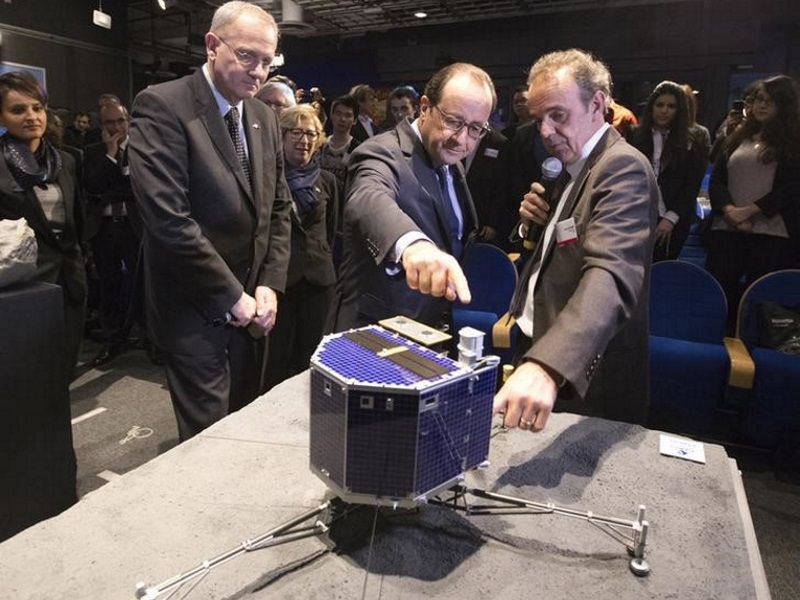- Home
- Science
- Science News
- Time Running Out for Comet Probe Philae
Time Running Out for Comet Probe Philae

A last-chance manoeuvre was attempted Sunday to shift the tiny lander into a sunnier angle for its battery-replenishing solar panels.
"Unfortunately this attempt didn't lead to contact," project manager Stephan Ulamec of German space agency DLR told AFP. "We didn't receive any signal."
"We are going to send a few more" commands in the coming days, he added.
In a first for space exploration, Philae was dropped onto the surface of comet 67P/Churyumov-Gerasimenko on November 12, 2014 after a 10-year, 6.5-billion-kilometre (four-billion-mile) journey through space piggybacking on mothership Rosetta, which is now orbiting the comet.
The washing machine-sized probe survived a rough landing, bouncing several times off the craggy comet surface and ending up at an angle in a shaded crevice.
Philae sent home data from about 60 hours of comet sniffing and prodding with eight of its 10 instruments before going into standby mode on November 15, 2014.
The lander's power pack was recharged as 67P drew closer to the Sun on its elliptical orbit, and Philae woke up on June 13, to great excitement on Earth.
It made eight intermittent contacts via Rosetta, only to fall silent again on July 9.
On Sunday, ground controllers sent a command to try to get Philae to budge, hoping this would shake any dust off its panels and better align it with the Sun.
Odds getting worse
"We have not gotten any feedback on its success," the DLR said in a video uploaded to Twitter.
It was possible Philae had received and executed the command, but could not talk to Rosetta.
DLR said a camera on Rosetta took a sequence of images which are being scrutinised for any signs of a dust cloud that could have been caused by Philae shifting position.
Scientists plan to send more commands to the robot lab in the coming days.
If there is no response, the communications systems will be switched to "listening mode" on the off chance that Philae does get a signal out.
But the odds are getting "worse and worse" as the comet moves away from the Sun.
By the end of January, the comet will be some 300 million kilometres (185 million miles) from the Sun.
Once its surface temperature falls below minus 51 degrees Celsius (minus 60 degrees Fahrenheit), Philae will no longer be able to operate.
"If we have heard nothing by end-January, it will be over" for Philae, said Philippe Gaudon, Rosetta project manager at France's CNES space agency.
The ground-breaking mission was conceived to learn more about comets, and possibly the origins of life on Earth.
Comets are pristine leftovers from the Solar System's formation some 4.6 billion years ago. Many experts believe they smashed into our infant planet, providing it with water and the chemical building blocks for life.
Philae has found several organic molecules.
Get your daily dose of tech news, reviews, and insights, in under 80 characters on Gadgets 360 Turbo. Connect with fellow tech lovers on our Forum. Follow us on X, Facebook, WhatsApp, Threads and Google News for instant updates. Catch all the action on our YouTube channel.
Related Stories
- Samsung Galaxy Unpacked 2025
- ChatGPT
- Redmi Note 14 Pro+
- iPhone 16
- Apple Vision Pro
- Oneplus 12
- OnePlus Nord CE 3 Lite 5G
- iPhone 13
- Xiaomi 14 Pro
- Oppo Find N3
- Tecno Spark Go (2023)
- Realme V30
- Best Phones Under 25000
- Samsung Galaxy S24 Series
- Cryptocurrency
- iQoo 12
- Samsung Galaxy S24 Ultra
- Giottus
- Samsung Galaxy Z Flip 5
- Apple 'Scary Fast'
- Housefull 5
- GoPro Hero 12 Black Review
- Invincible Season 2
- JioGlass
- HD Ready TV
- Laptop Under 50000
- Smartwatch Under 10000
- Latest Mobile Phones
- Compare Phones
- Redmi Note 15 5G
- Redmi Note 15 Pro 5G
- Redmi Note 15 Pro+ 5G
- Lava Play Max
- Poco C85 5G
- Honor Magic 8 Lite
- Jolla Phone
- Realme P4x 5G
- Asus ProArt P16
- MacBook Pro 14-inch (M5, 2025)
- OnePlus Pad Go 2
- Poco Pad M1
- Just Corseca Skywatch Pro
- Honor Watch X5
- Acerpure Nitro Z Series 100-inch QLED TV
- Samsung 43 Inch LED Ultra HD (4K) Smart TV (UA43UE81AFULXL)
- Asus ROG Ally
- Nintendo Switch Lite
- Haier 1.6 Ton 5 Star Inverter Split AC (HSU19G-MZAID5BN-INV)
- Haier 1.6 Ton 5 Star Inverter Split AC (HSU19G-MZAIM5BN-INV)

















